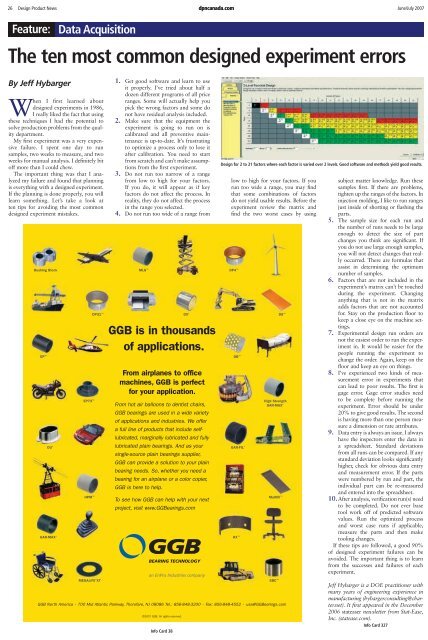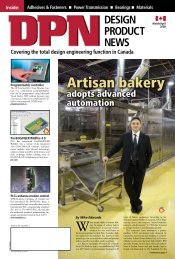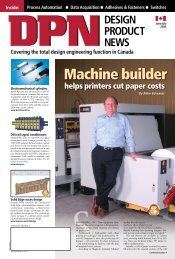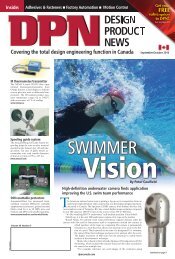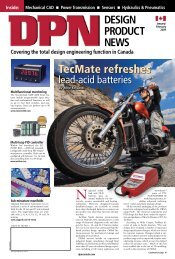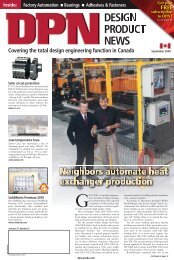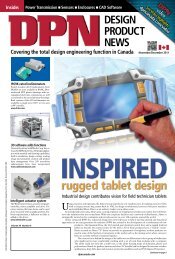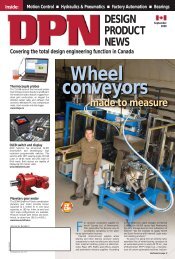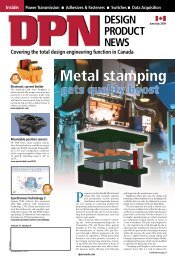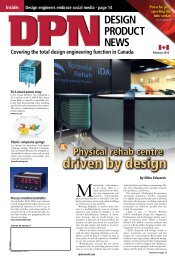DesIgn ProDuCT news - DPN Staff
DesIgn ProDuCT news - DPN Staff
DesIgn ProDuCT news - DPN Staff
Create successful ePaper yourself
Turn your PDF publications into a flip-book with our unique Google optimized e-Paper software.
26 Design Product News<br />
dpncanada.com June/July 2007<br />
Feature: Data Acquisition<br />
The ten most common designed experiment errors<br />
By Jeff Hybarger<br />
1. Get good software and learn to use<br />
it properly. I’ve tried about half a<br />
dozen different programs of all price<br />
When I first learned about ranges. Some will actually help you<br />
designed experiments in 1986, pick the wrong factors and some do<br />
I really liked the fact that using not have residual analysis included.<br />
these techniques I had the potential to 2. Make sure that the equipment the<br />
solve production problems from the quality<br />
experiment is going to run on is<br />
department.<br />
calibrated and all preventive main-<br />
My first experiment was a very expensive<br />
tenance is up-to-date. It’s frustrating<br />
failure. I spent one day to run to optimize a process only to lose it<br />
samples, two weeks to measure, and two after calibration. You need to start<br />
weeks for manual analysis. I definitely bit from scratch and can’t make assumptions<br />
off more than I could chew.<br />
from the first experiment.<br />
The important thing was that I analyzed<br />
3. Do not run too narrow of a range<br />
my failure and found that planning from low to high for your factors.<br />
is everything with a designed experiment. If you do, it will appear as if key<br />
If the planning is done properly, you will factors do not affect the process. In<br />
GGB_2681_FW_MultiAdUSA_<strong>DPN</strong>.qxd 4/17/07 10:22 AM Page 1<br />
learn something. Let’s take a look at<br />
ten tips for avoiding the most common<br />
designed experiment mistakes.<br />
Bushing Block<br />
EP <br />
EP73 <br />
GGB is in thousands<br />
of applications.<br />
From airplanes to office<br />
machines, GGB is perfect<br />
for your application.<br />
From hot air balloons to dentist chairs,<br />
GGB bearings are used in a wide variety<br />
of applications and industries. We offer<br />
a full line of products that include selflubricated,<br />
marginally lubricated and fully<br />
lubricated plain bearings. And as your<br />
DU ® GAR-FIL ®<br />
GAR-MAX ®<br />
HPM <br />
DP31 <br />
MEGALIFE ® XT<br />
4.<br />
reality, they do not affect the process<br />
in the range you selected.<br />
Do not run too wide of a range from<br />
MLG <br />
single-source plain bearings supplier,<br />
GGB can provide a solution to your plain<br />
bearing needs. So, whether you need a<br />
bearing for an airplane or a color copier,<br />
GGB is here to help.<br />
To see how GGB can help with your next<br />
project, visit www.GGBearings.com<br />
GGB North America • 700 Mid Atlantic Parkway, Thorofare, NJ 08086 Tel.: 856-848-3200 • Fax: 856-848-4552 • usa@GGBearings.com<br />
©2007 GGB. All rights reserved.<br />
Info Card 38<br />
DX ®<br />
Design for 2 to 21 factors where each factor is varied over 2 levels. Good software and methods yield good results.<br />
low to high for your factors. If you<br />
run too wide a range, you may find<br />
that some combinations of factors<br />
do not yield usable results. Before the<br />
experiment review the matrix and<br />
find the two worst cases by using<br />
DP4 <br />
DB <br />
HX <br />
DS <br />
High Strength<br />
GAR-MAX ®<br />
Multifil <br />
SBC <br />
subject matter knowledge. Run these<br />
samples first. If there are problems,<br />
tighten up the ranges of the factors. In<br />
injection molding, I like to run ranges<br />
just inside of shorting or flashing the<br />
parts.<br />
5. The sample size for each run and<br />
the number of runs needs to be large<br />
enough to detect the size of part<br />
changes you think are significant. If<br />
you do not use large enough samples,<br />
you will not detect changes that really<br />
occurred. There are formulas that<br />
assist in determining the optimum<br />
number of samples.<br />
6. Factors that are not included in the<br />
experiment’s matrix can’t be touched<br />
during the experiment. Changing<br />
anything that is not in the matrix<br />
adds factors that are not accounted<br />
for. Stay on the production floor to<br />
keep a close eye on the machine settings.<br />
7. Experimental design run orders are<br />
not the easiest order to run the experiment<br />
in. It would be easier for the<br />
people running the experiment to<br />
change the order. Again, keep on the<br />
floor and keep an eye on things.<br />
8. I’ve experienced two kinds of measurement<br />
error in experiments that<br />
can lead to poor results. The first is<br />
gage error. Gage error studies need<br />
to be complete before running the<br />
experiment. Error should be under<br />
20% to give good results. The second<br />
is having more than one person measure<br />
a dimension or rate attributes.<br />
9. Data entry is always an issue. I always<br />
have the inspectors enter the data in<br />
a spreadsheet. Standard deviations<br />
from all runs can be compared. If any<br />
standard deviation looks significantly<br />
higher, check for obvious data entry<br />
and measurement error. If the parts<br />
were numbered by run and part, the<br />
individual part can be re-measured<br />
and entered into the spreadsheet.<br />
10. After analysis, verification run(s) need<br />
to be completed. Do not ever base<br />
tool work off of predicted software<br />
values. Run the optimized process<br />
and worst case runs if applicable,<br />
measure the parts and then make<br />
tooling changes.<br />
If these tips are followed, a good 90%<br />
of designed experiment failures can be<br />
avoided. The important thing is to learn<br />
from the successes and failures of each<br />
experiment.<br />
Jeff Hybarger is a DOE practitioner with<br />
many years of engineering experience in<br />
manufacturing (hybargerconsulting@charter.net).<br />
It first appeared in the December<br />
2006 stateaser <strong>news</strong>letter from Stat-Ease,<br />
Inc. (statease.com).<br />
Info Card 327


